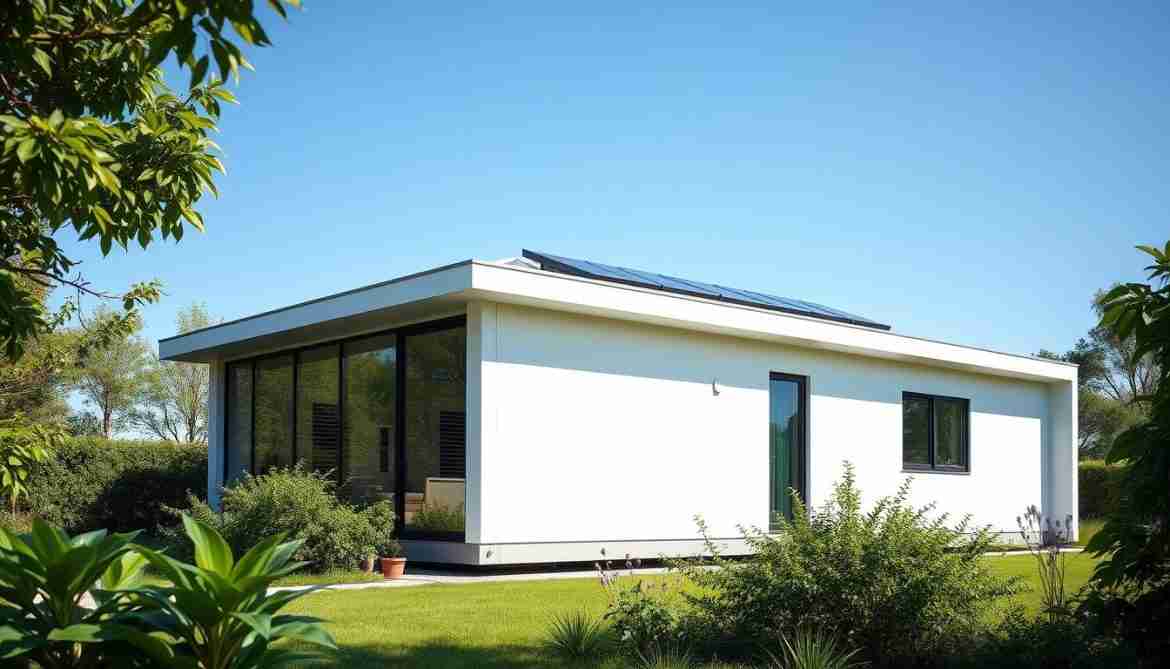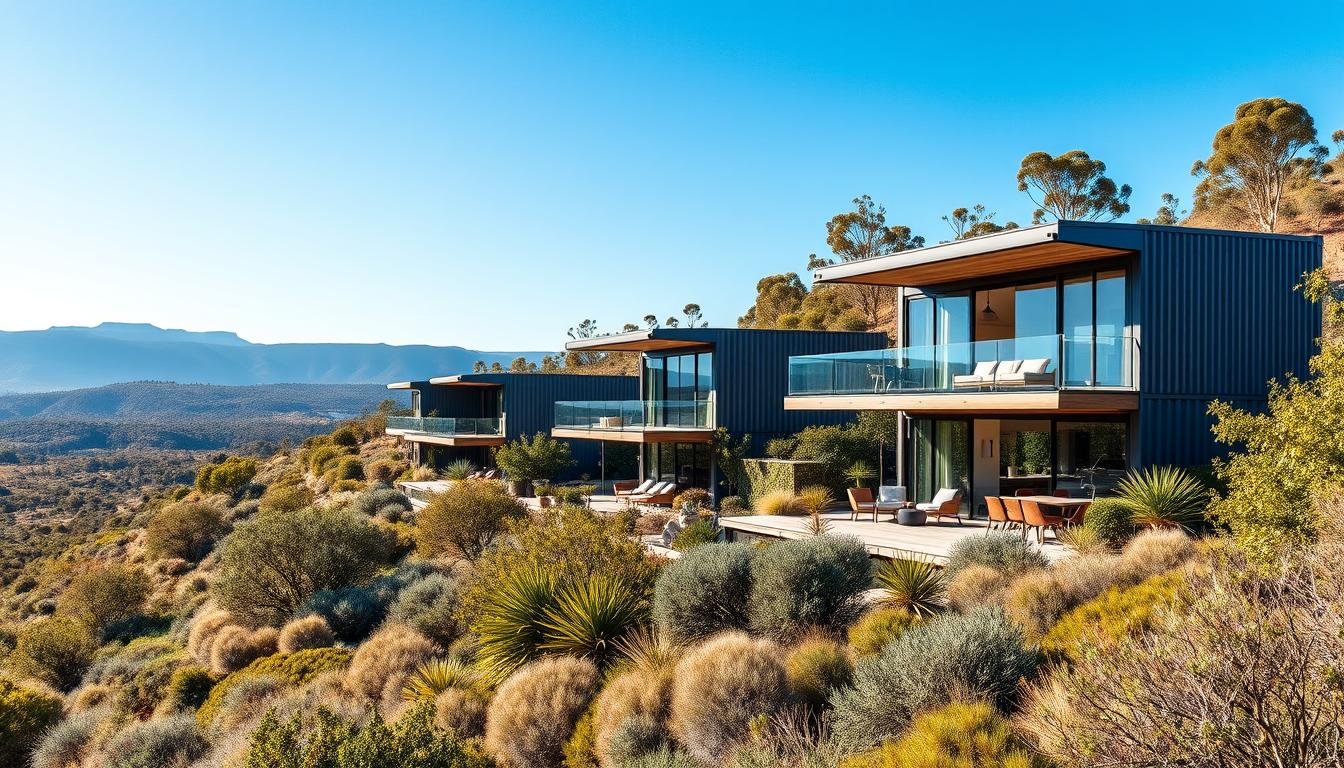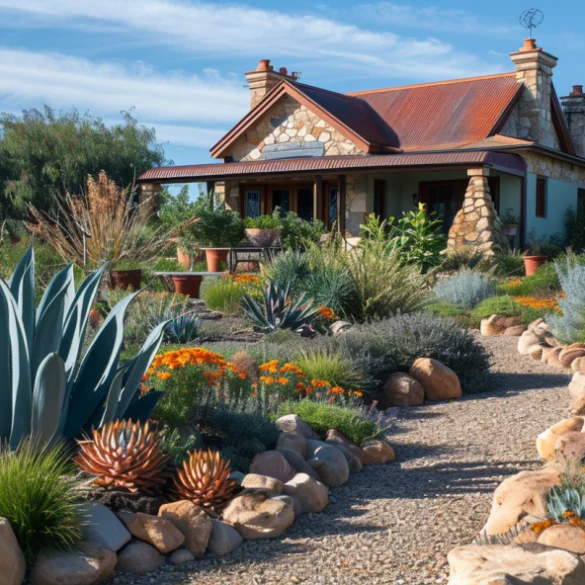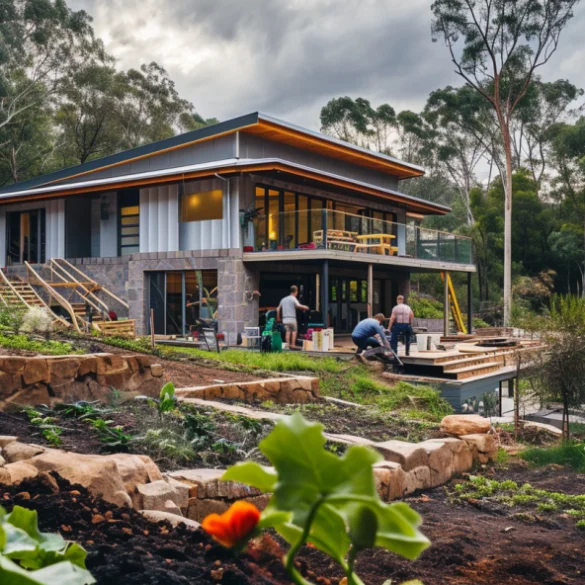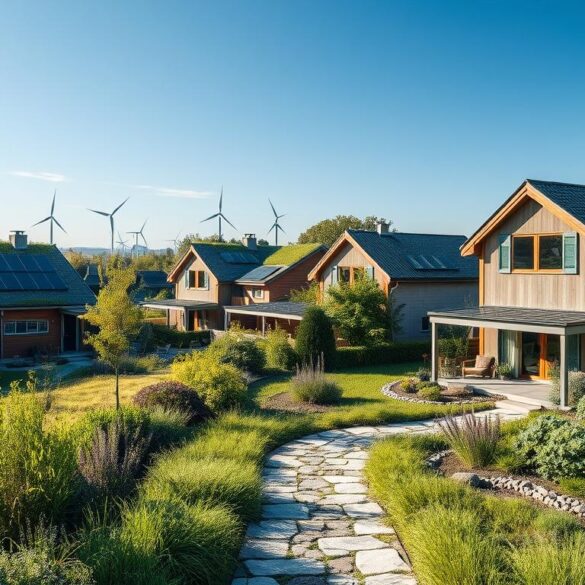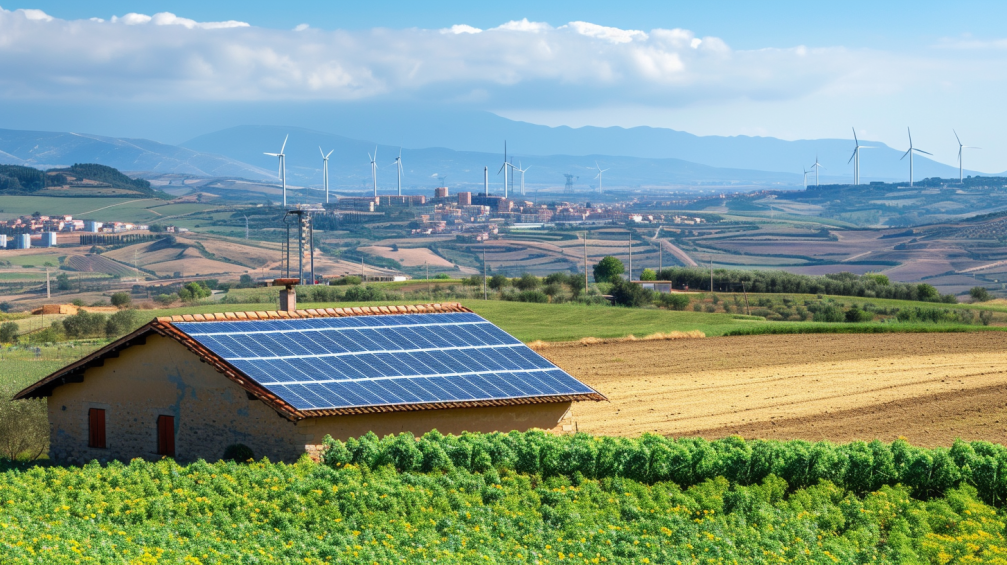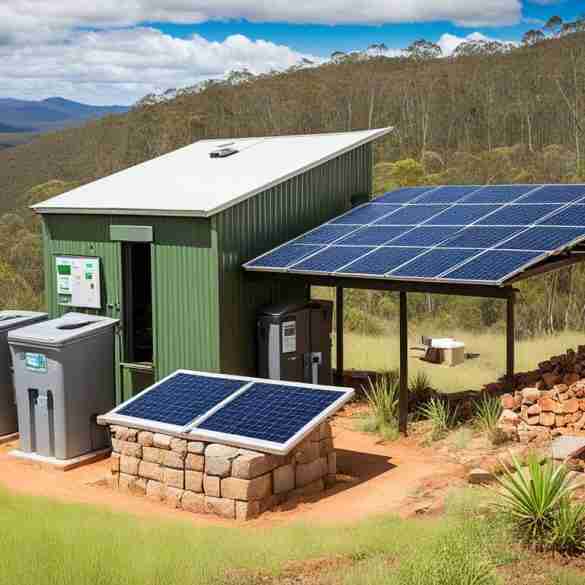Did you know that modern manufactured homes built after 1976 use up to 31% less heating fuel? This is thanks to special retrofit measures. It shows how much construction and energy efficiency have changed.
Energy-efficient modular homes are houses made for saving energy and using renewable energy. They often get certifications like ENERGY STAR® and Zero Energy Ready. Unlike regular homes, they are built on a permanent base in a factory. This lets them be very flexible and customizable.
They have high-performance windows, better insulation, and renewable energy systems. This means they save a lot of energy. They also follow the HUD Code, which means they are very energy-efficient. This makes them a good, affordable, and strong place to live.
To learn more about sustainable living, check out this article from Sustainable Home Magazine. It talks about using shipping containers for green living.
Choosing energy-efficient modular homes means you support sustainable living. They use less material and make less waste than regular houses. These homes are not only good for the planet but also help you save money on energy.
Table of Contents
Definition and Concept of Modular Homes
Modern modular homes are a mix of energy-saving construction and environmentally conscious design. They are built in sections, called modules, and then put together at the site. This method is fast and keeps high standards, often better than traditional homes.
These homes have better insulation, advanced HVAC systems, and energy-efficient windows. This makes them very energy efficient.
Key Energy-Efficient Features in Modular Homes
Modular homes have many energy-saving construction features. They include high-performance windows, better insulation, and advanced heating and cooling systems. These features help cut down energy use, making the home more sustainable and comfortable.
Benefits of Energy-Efficient Modular Homes
Modular homes save money and are good for the environment. They are made with less waste, following environmentally conscious design principles. They also cost less to build and use less energy, saving money on bills.
These homes are built to last, standing up well to weather conditions.
Modular Home Construction vs. Traditional Homes
Modular homes have big advantages over traditional homes. They are built in factories, which means less air leaks and better temperature control. This makes them ready to move in much faster, in 60 to 120 days, compared to 6 months to a year for traditional homes.
Modular homes also use modern designs and green materials. This makes them more sustainable than traditional homes.
| Feature | Modular Homes | Traditional Homes |
|---|---|---|
| Construction Timeline | 60 to 120 days | 6 months to 1 year |
| Building Standards | Equal or higher | Standard |
| Cost Efficiency | $100-$200/sq ft | Varies, generally higher |
| Energy Efficiency | High | Variable |
| Customization Options | Extensive | Extensive |
Modular homes are known for quick assembly and cost savings. They also focus on environmentally conscious design and energy-saving construction. This makes them a great choice for those who want to live in a modern, energy-efficient home while being kind to the environment.
Why Choose Modular Homes for Energy Savings?
Energy-efficient modular homes save a lot on energy costs. They are built with precision and use top-quality materials. This means big savings on energy and less upkeep.
Reduced Energy Consumption in Modular Homes
About 40% of a home’s energy goes to heating and cooling. Modular homes use advanced HVAC systems and better insulation. These features cut down energy use a lot.
They are key to sustainable housing options that save money and are good for the planet.
Lower Maintenance Costs for Modular Homes
Traditional HVAC systems last 15 to 25 years. Older systems should be replaced. Modular homes have the latest HVAC and materials, saving on maintenance.
This means your home’s systems last longer and cost less to maintain. It’s a big win for cost-saving green home features.
Return on Investment for Energy-Efficient Modular Homes
Investing in energy-efficient modular homes is a smart move. You can get tax breaks for upgrades like new HVAC systems. Programs like EmPower New York can help too.
These initial cost-saving green home features lead to big savings later on.
Long-Term Savings Potential
Energy-efficient modular homes save a lot in the long run. Up to 30% of heating and cooling loss comes from windows and doors. Upgrading these in modular homes cuts energy bills a lot.
Programs like the NYSERDA Comfort Home Program offer up to $4,000 for improvements. These make sustainable housing options more affordable and smart.
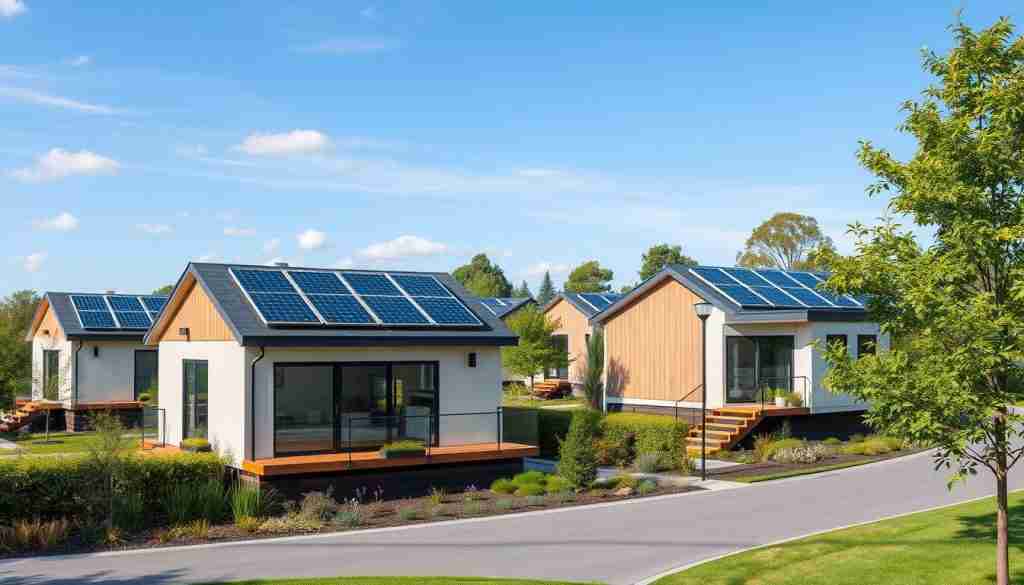
How Do Energy-Efficient Modular Homes Work?
Energy-efficient modular homes use new tech to save energy and protect the planet. They are built in a factory. This lets builders control the quality and make sure everything is just right.
Energy-Saving Construction Materials
These homes use special materials to save energy. Things like Structural Insulated Panels (SIPS) and advanced insulation make them tight. This means less air leaks and more energy saved.
Sustainable Home Magazine says these materials help make homes better for the environment. They also help reduce waste during building.
Smart Technology and Appliances in Modular Homes
Smart tech and energy-saving appliances are key. LED lights use much less energy than old bulbs. Homes also have ENERGY STAR® appliances that use less power.
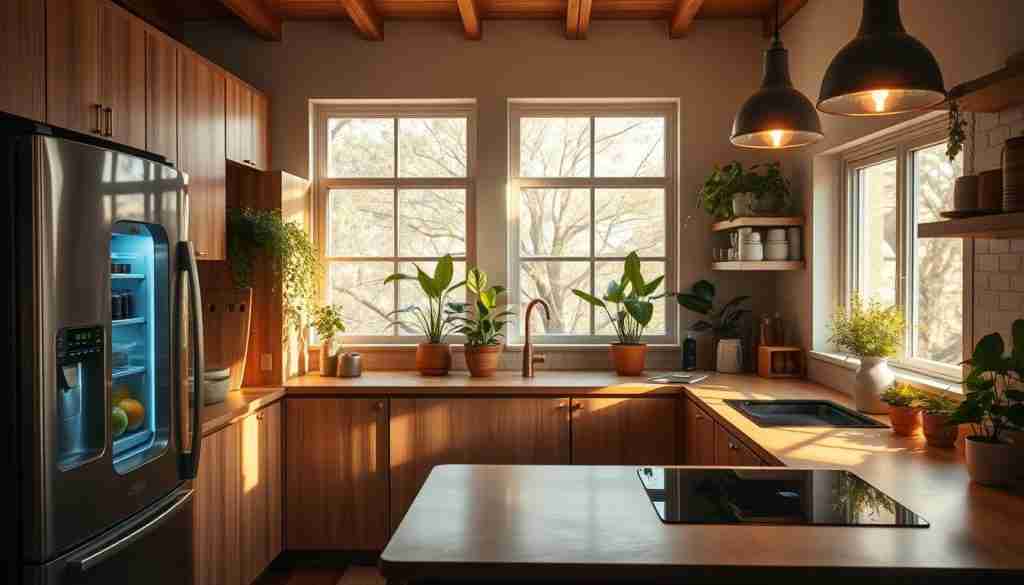
Efficient Heating and Cooling Systems
The heating and cooling systems in these homes are top-notch. They use less energy but still keep you comfy. For example, the Rheem® ProTerra® hybrid heat pump water heater is very efficient.
The factory setting helps make sure these systems work their best. This means they use even less energy.
Passive Design Strategies in Modular Homes
Passive solar design is used to use the sun’s energy. Homes are built to catch sunlight and keep warmth in. This can cut energy loss by 30-50%.
Landscaping and design also help. They make homes need less heating and cooling. This makes homes more energy-efficient and helps the planet. Companies like Tidewater Custom Modular Homes focus on these designs.
How to Achieve a 30% Reduction in Energy Bills with Modular Homes
Getting a 30% cut in energy bills with energy-efficient modular homes is doable. Focus on insulation, lighting, appliances, and renewable energy. This way, you can lower your energy costs a lot.
Key Factors Contributing to 30% Energy Bill Reduction
Good insulation is key to saving energy. It keeps your home warm in winter and cool in summer. Energy-efficient homes also have tight seals to stop air leaks.
Energy-Efficient Lighting and Appliances
LED bulbs and ENERGY STAR®-certified appliances help a lot. They use less power and work smarter. Replacing old stuff with new can save a lot on bills.
Optimizing Energy Usage in Modular Homes
Smart home tech is great for saving energy. Things like programmable thermostats and smart lights save power. They make your home comfy and your bills lower.
Utilizing Solar Panels and Renewable Energy in Modular Homes
Solar panels are a big plus for energy-efficient homes. They make clean energy and lower your bills. Sustainable Home Magazine says solar and other green energy make homes better and cheaper.
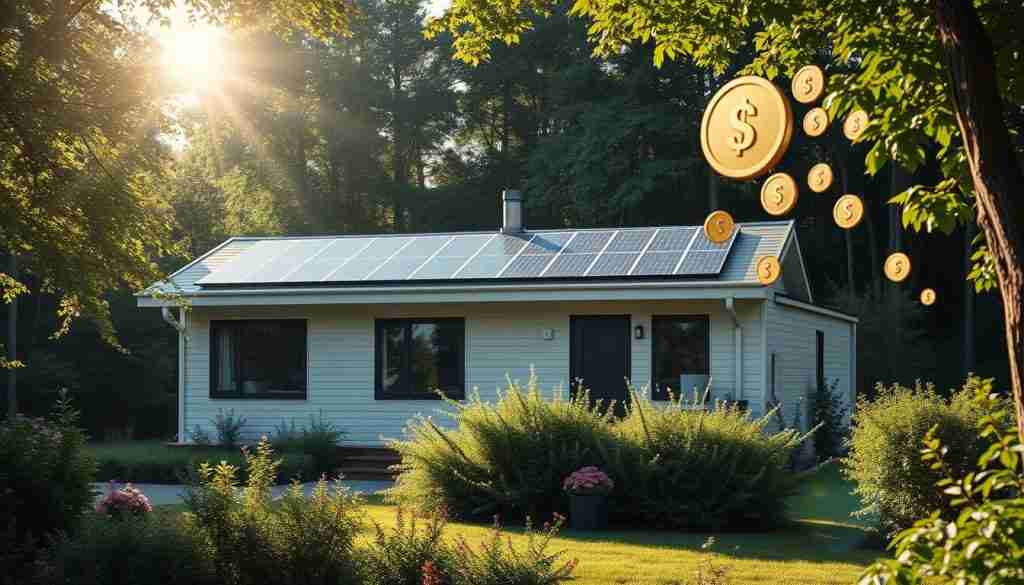
Using these tips and adding energy-saving tech can cut your bills. Modular homes are a smart choice for those wanting to save energy and the planet.
What Are the Costs Involved in Building an Energy-Efficient Modular Home?
Building an energy-efficient modular home costs a lot. This includes money for top-notch materials and new tech. But, you save money on energy and upkeep in the long run. Plus, you can get help with the costs through rebates and incentives.
Initial Costs vs. Long-Term Savings
A modular home can cost between $120,000 and $270,000. Prices can go from $100 to $250 per square foot. Even though it costs more at first, you save on energy and upkeep later.
Cost of Energy-Efficient Materials and Technologies
Using energy-saving materials and tech costs more upfront. Things like better HVAC, smart appliances, and insulation can add up. But, they save you money on bills in the long run.
Incentives and Rebates for Energy-Efficient Homes
Many places offer money back for building green homes. These incentives help make eco-friendly homes more affordable. They encourage using energy wisely and living sustainably.
Financing Options for Modular Homes
There are many ways to finance green homes. You can get loans, green mortgages, or special financing for eco-friendly homes. This makes it easier to buy a home that’s good for the planet.
| Aspect | Cost Range |
|---|---|
| Base Price Per Square Foot | $50 – $100 |
| Custom Modular Home Price Per Square Foot | $100 – $250 |
| Two-Story Modular Homes Base Model | $70,000 – $140,000 |
| Land Preparation | $4,000 – $11,000 |
| Foundation | $6,000 – $20,000 |
| Delivery and Assembly | $52,000 – $167,000 |
| Additional Construction Costs | Varies by Location |
| Two-Car Garage | $28,000 |
Who Can Benefit the Most from Energy-Efficient Modular Homes?
Energy-efficient modular homes are becoming more popular. They help many people save money and protect the environment. These homes are great for families, those who care about the planet, retirees, and investors.
Families Looking to Reduce Utility Bills
For families wanting to cut down on utility bills, these homes are a good choice. In North Titusville, for example, they can save homeowners about $900 a year. This is because they use less energy and cost less to run.
Eco-Conscious Homebuyers
People who care about the environment like these homes. They are built in a way that uses less waste and green materials. This makes them better for the planet and reduces their carbon footprint.
Retirees Seeking Low-Maintenance Living
Retirees like these homes because they are easy to take care of. They are built in a controlled factory setting, which means they last longer and have fewer problems. They also come with smart home features that make life easier for older adults.
Investors Interested in Sustainable Property
Investors also see the value in these homes. They save money on energy and are in demand because they are green. Companies like Dvele make these homes, ensuring they are a good investment for both buyers and investors.
Here’s a comparison of energy-efficient modular homes and traditional homes:
| Aspect | Modular Homes | Traditional Homes |
|---|---|---|
| Annual Energy Savings | $900 (Alabama Power estimate) | Varies, typically lower |
| Construction Waste | Minimized in factory settings | Higher due to on-site construction |
| Maintenance Requirements | Low | Moderate to high |
| Sustainability | Higher due to green materials | Lower, depends on the builder |
| Initial Cost | Average $81,100 (U.S. Census Bureau) | Average $395,200 (U.S. Census Bureau) |
| Durability | High (Factory-controlled) | Variable |
How Do Energy-Efficient Modular Homes Help the Environment?
Energy-efficient modular homes are changing the housing world. They use the latest green home features. This makes them great for the environment and helps fight climate change.
Reduction in Carbon Footprint Through Energy Efficiency
These homes reduce carbon emissions significantly. They use better insulation and HVAC systems, which means less energy is lost in winter and summer.
They also have ENERGY STAR appliances and lights. These save up to 75% of energy compared to old ways. This makes the homes even greener.
Sustainable Construction Practices in Modular Homes
Building modular homes is done with the planet in mind. They make less waste than old ways. This lowers their environmental impact.
They are built in factories with care. This means fewer gaps and leaks. This boosts their energy efficiency.
Use of Renewable Energy in Modular Homes
Renewable energy is key in these homes. Builders prepare for solar panels. This can make homes use no energy at all.
Some homes even use geothermal systems. This cuts down on electricity and fossil fuel use.
Modular Homes and Reduced Resource Usage
Modular homes use resources wisely. They use recycled steel and eco-friendly finishes. They also add extra insulation.
This means they need fewer resources. It lowers their carbon footprint and saves money over time.
Many green features in these homes get tax breaks. This makes them smart for the planet and wallet. As more people want energy-efficient homes, these houses could be worth more in the future.
When Is the Best Time to Invest in an Energy-Efficient Modular Home?
Figuring out the best time to buy an energy-efficient modular home is key. You need to look at the market, economy, seasons, and government help. These things can help your decision, making it a smart choice.
Understanding Market Trends for Energy-Efficient Homes
Energy-efficient homes are getting more popular. The price of new homes in the US was $400,600 in February 2022. Modular homes, with their green features, are a top pick. Buying now could mean big savings and a higher home value later.
Economic Conditions Favoring Modular Home Investments
Now is a good time to invest in modular homes. Home prices are up, and there’s less to choose from. Modular homes save money and are built fast, giving you quick returns.
Seasonal Factors Affecting Modular Home Construction
Seasons can change how much you pay for a modular home. Building when it’s not busy can save money and time. Plus, homes built in factories are less affected by weather, ensuring quality all year.
Government Regulations and Policies Supporting Modular Homes
Government support for green homes is growing. There are tax breaks and rebates for energy-efficient homes. Knowing about these can make your investment even better.
In short, the best time to buy a modular home is when you understand the market, economy, seasons, and government help. These factors make a strong case for investing in modular homes now.
Where to Find the Best Energy-Efficient Modular Home Builders?
Choosing the right modular home builder is key. It affects your home’s quality and efficiency. Here are tips and insights on top builders, certifications, and customer feedback.
Top Modular Home Builders Specializing in Energy Efficiency
Top builders for energy-efficient homes include Clayton Homes and Champion Homes. Impresa Modular and Commodore Homes are also known for their green homes. Deer Valley Homebuilders, Blu Homes, and Millbrook Modular Homes are leaders too.
Millbrook Modular Homes makes homes with 30% less heating costs. They use green technologies and meet ENERGY STAR standards. These builders focus on energy-saving homes.
Qualities to Look for in an Energy-Efficient Modular Home Builder
When picking a builder, consider a few things:
- Industry Experience: Choose builders with a strong modular construction history. Millbrook Modular Homes has over 30 years of experience.
- Customization Options: Make sure the builder offers many plans and custom options. Millbrook Homes has over 500 plans.
- Energy-Efficient Construction Experts: Check if the builder uses energy-saving materials. Many are part of the Modular Home Builders Association (MHBA).
- Reputation and Customer Service: Look at their Better Business Bureau rating and customer reviews. Happy customers mean good service.
Customer Reviews and Testimonials for Modular Home Builders
Customer feedback is very helpful. It shows how builders perform in quality, communication, and timing. Sustainable Home Magazine often shares reviews to help you choose.
Industry Certifications for Energy-Efficient Home Builders
Certified green builders are key for energy-efficient homes. Certifications show they follow sustainable standards. Millbrook Modular Homes is a great example, offering financing quickly.
Looking for the best modular home builders means researching certifications, customer satisfaction, and builder skills. This ensures your home is built well, saving you money and energy for years.
How to Maintain and Maximize Energy Efficiency in Modular Homes
To keep your modular home energy-efficient, you need to do a few things. Regular upkeep, smart upgrades, and using the latest tech are key. These steps help you save energy and keep your home comfy.
Regular Maintenance Tips for Energy-Efficient Homes
Keeping your home efficient starts with regular checks. Make sure your HVAC is working well to save on bills. Also, seal any gaps around windows and doors to stop air leaks.
Change your furnace filters often. This helps your furnace work better and saves energy. These simple steps help a lot with energy use.
Upgrading Systems and Technologies for Enhanced Efficiency
Upgrading your home can save a lot of energy. Get appliances with the ENERGY STAR label. Also, choose efficient heating and cooling systems.
Adding cool roof coatings and new windows can help too. Even small changes, like using CFLs, can cut down energy use.
Monitoring Energy Usage with Smart Systems
Smart systems let you watch and control your energy use. Use smart thermostats and energy monitors. They help you save energy and learn how to use it better.
Preventing Energy Loss Through Insulation and Sealing
Insulation and sealing stop energy from escaping. Insulate your crawl space, floor, and roof. This keeps your home warm or cool without using too much energy.
Adding insulation under the floor helps too. Use materials like blown fiberglass. Also, get energy-saving windows and weatherstrip doors. These steps save you money in the long run.
By following these tips, you can keep your home energy-efficient. This makes your home comfortable and saves money. For more info, check out Sustainable Home Magazine.

